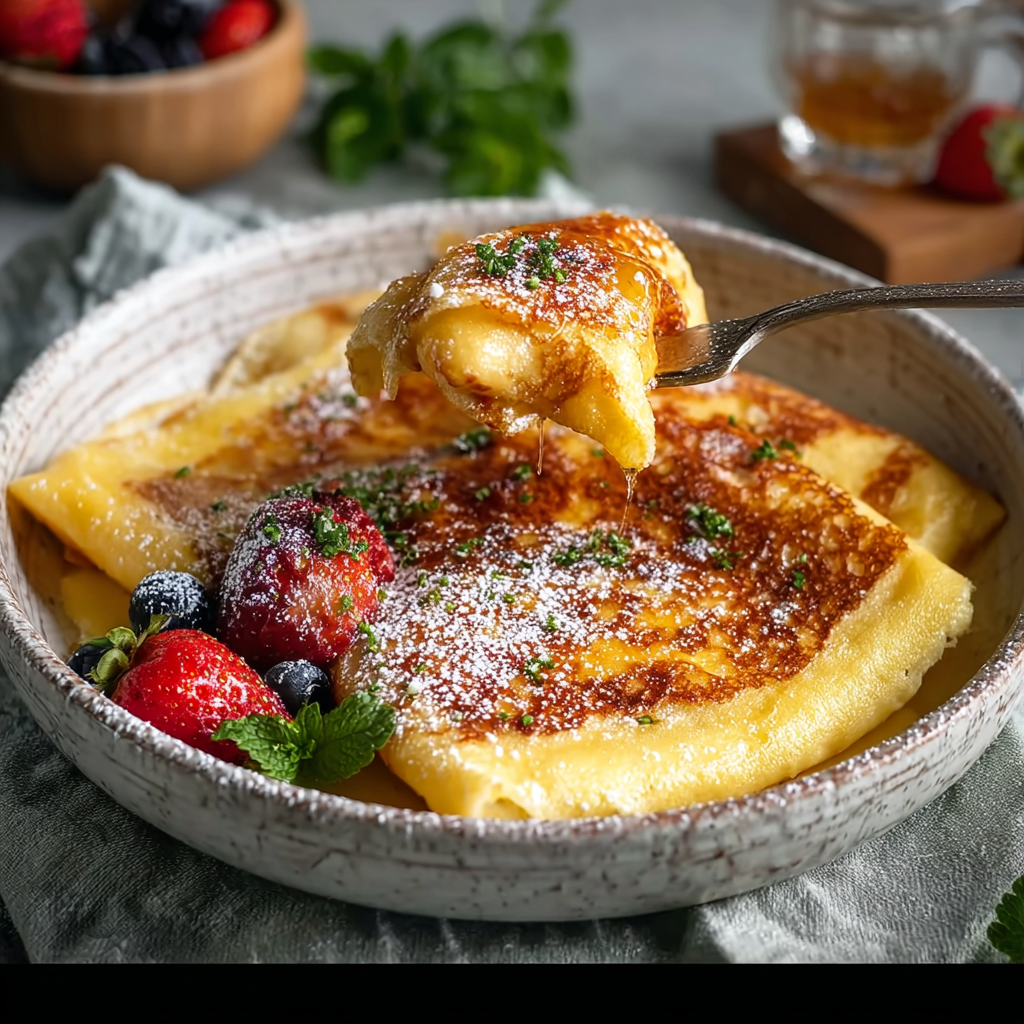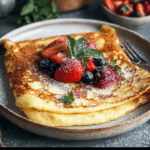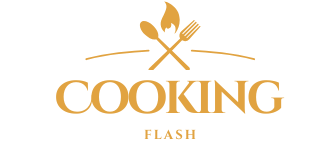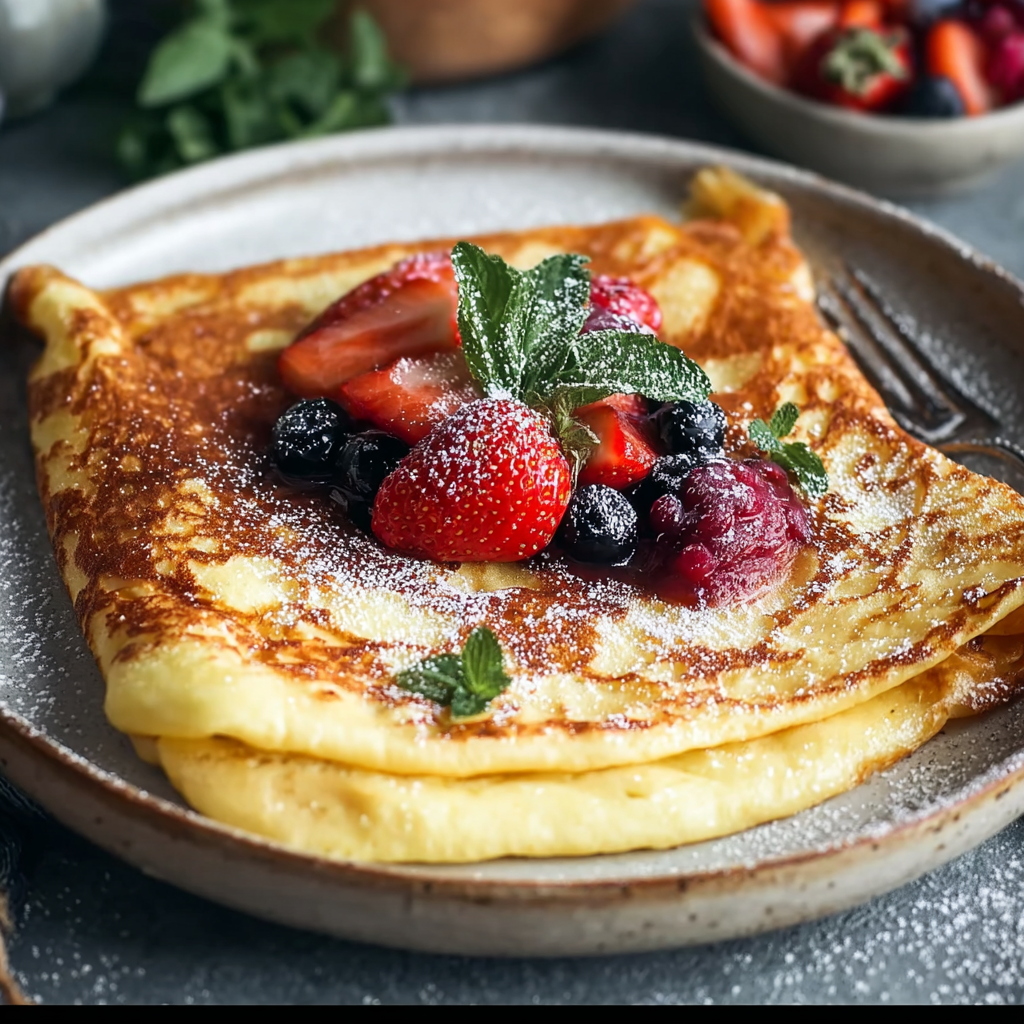There’s something magical about a German pancake, often called a “Dutch Baby.” The moment it comes out of the oven, puffed up like a golden cloud with edges curling dramatically, you can’t help but feel a little awe. The buttery aroma fills the kitchen, mingling with a hint of sweetness, promising a breakfast that feels both cozy and impressive. Trust me, you’re going to love this, because every bite is soft, eggy, and melts in your mouth, while the crisp edges add just the right touch of texture.
Behind the Recipe
This recipe carries a sense of nostalgia for many families. German pancakes are often made on lazy weekend mornings when everyone can gather around the oven, waiting for that magical rise. I remember the first time I baked one—it felt like a mini science experiment, watching the batter transform into something so beautiful. It’s a dish that invites conversation, laughter, and that delightful pause when everyone admires the oven-fresh masterpiece before digging in.
Recipe Origin or Trivia
Despite their name, German pancakes aren’t truly from Germany. They’re more closely related to the American take on a baked pancake and are sometimes called “Dutch Babies.” The “Dutch” in the name actually comes from a mispronunciation of “Deutsch,” meaning German. These pancakes rose to popularity in the United States in the early 1900s, especially in the Pacific Northwest, where they were served in diners as a show-stopping breakfast item.
Why You’ll Love German Pancakes
When it comes to breakfast recipes, this one has it all. Here’s why it’s going to be your new favorite:
Versatile: Enjoy them sweet with fruit and syrup or savory with herbs and cheese.
Budget-Friendly: Just eggs, flour, milk, and butter—simple pantry staples turn into something spectacular.
Quick and Easy: A few minutes of prep and the oven does the rest.
Customizable: Add cinnamon, vanilla, or even lemon zest for a personal twist.
Crowd-Pleasing: The dramatic puff always gets “oohs” and “aahs” at the table.
Make-Ahead Friendly: Batter can be mixed the night before for an effortless morning.
Great for Leftovers: Reheat slices in the oven or skillet, and they’re just as good.
Chef’s Pro Tips for Perfect Results
The key to mastering German pancakes is in the little details.
- Use a preheated skillet for maximum puff and crispy edges.
- Room temperature eggs and milk help the batter rise better.
- Don’t open the oven door while baking or you’ll lose that magical lift.
- Whisk the batter until silky smooth for the perfect texture.
Kitchen Tools You’ll Need
Before we dive in, gather a few essentials:
Oven-safe skillet or baking dish: A cast-iron skillet works wonders.
Mixing bowl: To whisk together your batter.
Whisk or blender: Ensures the batter is smooth and lump-free.
Measuring cups and spoons: For accuracy and consistency.
Ingredients in German Pancakes
Every ingredient has a role to play in creating that golden, puffed-up beauty.
- Large eggs: 3 They provide the lift and custard-like texture.
- All-purpose flour: 1/2 cup Creates structure and stability.
- Whole milk: 1/2 cup Brings creaminess and moisture.
- Unsalted butter: 2 tablespoons Gives richness and helps crisp the edges.
- Sugar: 1 tablespoon Adds just a hint of sweetness.
- Vanilla extract: 1 teaspoon For warmth and flavor depth.
- Salt: 1/4 teaspoon Balances sweetness and enhances taste.
Ingredient Substitutions
Sometimes you may need to adjust based on what’s in your pantry.
Flour: Use gluten-free all-purpose blend.
Milk: Almond, oat, or soy milk work beautifully.
Sugar: Honey or maple syrup as natural sweeteners.
Butter: Coconut oil for a dairy-free version.
Ingredient Spotlight
Eggs: These are the backbone of the recipe, giving the pancake its airy rise and custardy center.
Butter: Beyond flavor, butter helps create those irresistible crisp edges that make a German pancake so memorable.

Instructions for Making German Pancakes
Now comes the fun part—watching the magic unfold in your kitchen.
- Preheat Your Equipment: Place your skillet in the oven and preheat to 425°F (220°C).
- Combine Ingredients: Whisk eggs, milk, flour, sugar, vanilla, and salt until the batter is completely smooth.
- Prepare Your Cooking Vessel: Carefully remove the hot skillet, add butter, and swirl until melted and sizzling.
- Assemble the Dish: Pour the batter into the skillet over the melted butter.
- Cook to Perfection: Bake for 18–20 minutes until the pancake is puffed and golden brown.
- Finishing Touches: Dust with powdered sugar or drizzle with syrup if desired.
- Serve and Enjoy: Slice into wedges and serve hot with your favorite toppings.
Texture & Flavor Secrets
The real charm of a German pancake lies in the contrast. The center is soft, tender, and almost custard-like, while the edges rise tall and turn beautifully crisp. Butter lends richness, sugar adds subtle sweetness, and the vanilla rounds everything out with warmth. Each bite is a perfect balance of airy and hearty.
Cooking Tips & Tricks
A few extra pointers to keep things easy:
- Preheating the skillet is crucial for dramatic puff.
- For a smoother texture, blend the batter instead of whisking.
- Add a sprinkle of cinnamon or lemon zest for extra flavor.
What to Avoid
Even simple recipes can go sideways if you’re not careful.
- Don’t skip preheating the skillet, or your pancake won’t rise properly.
- Avoid overmixing the batter, which can make it dense.
- Resist opening the oven door mid-bake—it deflates the rise.
Nutrition Facts
Servings: 4
Calories per serving: ~180
Note: These are approximate values.
Preparation Time
Prep Time: 5 minutes
Cook Time: 20 minutes
Total Time: 25 minutes
Make-Ahead and Storage Tips
If you’d like to make mornings even easier, prepare the batter the night before and store it in the fridge. The pancake itself is best enjoyed fresh, but leftovers can be wrapped in foil and refrigerated for up to 2 days. To reheat, pop slices in a 350°F oven for about 5 minutes. Freezing isn’t ideal, but it can be done if needed—just thaw and reheat gently.
How to Serve German Pancakes
There are endless ways to enjoy them. Sprinkle with powdered sugar and a squeeze of lemon juice for a classic touch, pile on fresh berries and whipped cream for something indulgent, or keep it savory with herbs and cheese. Pair it with coffee or a glass of orange juice for the perfect breakfast spread.
Creative Leftover Transformations
Leftovers don’t have to be boring. Warm slices make a fantastic base for fruit compote, or you can top them with peanut butter and bananas for a snack. For something savory, fold in sautéed veggies and cheese for a quick meal.
Additional Tips
For an extra pop of flavor, try adding a teaspoon of cinnamon or nutmeg to the batter. If you love citrus, lemon zest brightens the flavor beautifully. Always serve it straight from the oven for maximum wow factor.
Make It a Showstopper
Serve your pancake in the skillet straight from the oven, dusted generously with powdered sugar. Garnish with bright berries or thin lemon slices for contrast. The dramatic puff and golden color make it a centerpiece all on its own.
Variations to Try
- Lemon Poppy Seed: Add lemon zest and a teaspoon of poppy seeds.
- Apple Cinnamon: Layer thin apple slices in the skillet before pouring the batter.
- Chocolate Lover’s: Stir cocoa powder into the batter and dust with cocoa sugar.
- Savory Herb: Mix in chives, thyme, and a sprinkle of cheese for a dinner-worthy version.
- Berry Burst: Fold in blueberries or raspberries for a fruity surprise.
FAQ’s
Q1: Can I use a baking dish instead of a skillet?
Yes, any oven-safe dish works, but cast iron gives the best results.
Q2: Why didn’t my pancake rise?
Your skillet may not have been hot enough, or your oven door was opened too soon.
Q3: Can I make this dairy-free?
Absolutely, just use plant-based milk and butter alternatives.
Q4: What toppings work best?
Powdered sugar, berries, lemon juice, or syrup are all classics.
Q5: Can I double the recipe?
Yes, just use a larger skillet or two smaller ones to avoid overcrowding.
Q6: Is it sweet or savory?
It can be either—adjust toppings to suit your taste.
Q7: Do I need to grease the pan if I use butter?
No, the butter melted in the skillet provides all the fat needed.
Q8: How do I know when it’s done?
The edges will be puffed and golden, and the center should look set.
Q9: Can I freeze German pancakes?
It’s not ideal, but you can freeze them for up to a month. Reheat in the oven for best texture.
Q10: Can kids help with this recipe?
Yes, kids can whisk the batter and choose toppings, though handling the hot skillet should be left to adults.
Conclusion
German pancakes are one of those recipes that feel like magic in the kitchen. With just a handful of simple ingredients, you create something so spectacular, both in taste and presentation. It’s the kind of dish that brings people together, sparks delight, and leaves you wanting to make it again and again. Let me tell you, it’s worth every bite
Print
German Pancakes
- Prep Time: 5 minutes
- Cook Time: 18 to 20 minutes
- Total Time: 25 minutes
- Yield: 4 servings
- Category: Breakfast/Brunch
- Method: Baked
- Cuisine: American
- Diet: Vegetarian
Description
A dramatic, oven-baked pancake with a custardy center and crisp, puffed edges, perfect for a show-stopping breakfast or brunch. Trust me, you are going to love this.
Ingredients
- Large eggs: 3
- All-purpose flour: 1/2 cup
- Whole milk: 1/2 cup
- Unsalted butter: 2 tablespoons
- Sugar: 1 tablespoon
- Vanilla extract: 1 teaspoon
- Salt: 1/4 teaspoon
Instructions
- Preheat Your Equipment: Preheat oven to 425°F (220°C). Place an oven-safe skillet or baking dish in the oven while it preheats so it becomes thoroughly hot.
- Combine Ingredients: In a mixing bowl whisk together 3 large eggs, 1/2 cup whole milk, 1/2 cup all-purpose flour, 1 tablespoon sugar, 1 teaspoon vanilla extract, and 1/4 teaspoon salt until the batter is completely smooth and free of lumps.
- Prepare Your Cooking Vessel: Carefully remove the hot skillet from the oven, add 2 tablespoons unsalted butter, and swirl until the butter is melted and sizzling, coating the pan.
- Assemble the Dish: Pour the smooth batter into the hot, butter-coated skillet, tilting slightly if needed to distribute evenly.
- Cook to Perfection: Return the skillet to the oven and bake for 18 to 20 minutes until the pancake is dramatically puffed, golden brown on the edges, and the center is set.
- Finishing Touches: Remove from oven, dust with powdered sugar or add a squeeze of lemon, fresh berries, or a drizzle of syrup to taste.
- Serve and Enjoy: Slice into wedges and serve immediately while puff is at its peak. Leftovers can be reheated in a 350°F (175°C) oven for best texture.
Notes
- Use a preheated oven-safe skillet for the best rise and crisp edges.
- Whisk or blend the batter until silky smooth for a light, custardy center.
- Do not open the oven door while baking or you will lose the rise.
- For dairy-free versions, substitute plant-based milk and a neutral oil or vegan butter.
Nutrition
- Serving Size: 1/4 recipe (1 wedge)
- Calories: 190
- Sugar: 4.6 g
- Sodium: 68 mg
- Fat: 10.5 g
- Saturated Fat: 5.4 g
- Unsaturated Fat: 5.1 g
- Trans Fat: 0.3 g
- Carbohydrates: 15.6 g
- Fiber: 0.5 g
- Protein: 7 g
- Cholesterol: 159 mg

